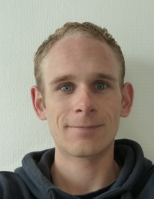 In this thesis candidate Oxygen Transport Membranes (OTMs) are studied. The general topic was to characterize and improve the structural and oxygen transport properties.
In this thesis candidate Oxygen Transport Membranes (OTMs) are studied. The general topic was to characterize and improve the structural and oxygen transport properties.
‘The ultimate aim is to obtain viable OTMs for application in power generation with carbon capture,’ says Rian Ruhl. ‘The most important properties to be improved, are magnitude of the oxygen flux and the chemical stability of the membrane material in demanding atmospheres containing steam and acidic gases.’
Rian worked on this as a member of the Mesa+ Inorganic Membranes Group. The project was part of the Green-CC Framework Program, initiated and supported by the European Commission.
‘18 partners worked on this program,’ Rian says. ‘We had half-yearly meetings involving researchers from various universities, companies and knowledge institutions. It was inspiring to hear of their results, for example on progress on materials properties. From the meetings we initiated collaborative projects. Also it led to interesting subprojects, for example to be performed by master students. Among other things, they designed novel simulations or integrated new materials within already existing membrane modules.’
In Rian Ruhls thesis work various topics passed by, all related to OTM. ‘Being part of the European program Green-CC offered freedom, as well as it provided me guidance,’ he says. ‘Working on parallel themes, I always found myself making vast progress on at least one of the topics.’
Some chapters
For example a new synthesis route of perovskite-type oxides (SrTi1-xFexO3-δ) was described. Here, a powder with an ultra-fine crystallite size of 20-40 nm was produced with excellent sinterability.
In a subsequent chapter the influence of yttrium dopant concentration on the performance and stability of perovskite-type oxides Ba0.5Sr0.5(Co0.8Fe0.2)1-xYxO3-δ was discussed. ‘Without yttrium doping, the material exhibits the highest oxygen flux through mixed ionic-electronic conducting membranes,’ Rian says. ‘Using Electrical Conductivity Relaxation and Scanning Electron Microscopy, results show that yttrium doping markedly improves the structural and performance stability of membranes.’
Experiments
Further, high-temperature X-ray diffraction studies showed that partial substitution can be a good tool to tailor membrane material properties.
‘Here, also electrical conductivity relaxation experiments were used,’ Rian says. ‘I benefited a great deal from the experimental expertise and equipment of colleagues and groups from within Mesa+. I believe these kinds of collaboration and sharing of knowledge and equipment can be further improved within Mesa+.’
Details
Rian: ‘Also some fundamental questions were highlighted within my thesis, making my work even the more interesting and varied. I owe great thanks to Professor Henny Bouwmeester who always paid attention to details. He was always willing to spend time and effort to follow my progress and to make sure I expressed the results carefully. I have adopted this approach in my research and working attitude.’
Océ
While working on his last chapters and articles, Rian already found himself working at Océ in Venlo, in the South of the Netherlands. ‘I found a very interesting R&D job here,’ he says.
‘I can contribute to bring digital printing technologies further on the medium term. Working in a different team and in a different corporate culture, I will most certainly develop as a researcher and as a company employee. The time scales are tighter here, and I have a little less room to work on the details. My characterization techniques and experimental skills certainly are of great value here, for instance crystallography is used to bring this technology further and stay competitive within the printing market.’
